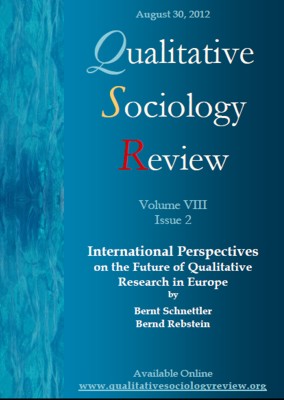Analyzing Social Ties in Total Institutions
DOI:
https://doi.org/10.18778/1733-8077.8.2.02Keywords:
Isolation, Intimacy, Social Ties, Residential Youth Care, Total InstitutionsAbstract
A common view is that an individual delinquent can be rehabilitated in a “home” in the countryside, away from his or her original urban social ties. An ironic result is new social ties with other juvenile delinquents as they spend a considerable amount of time together at a secluded institution. Drawing on ethnographic studies in residential care institutions, this article discusses two aspects to consider when analyzing social ties in such settings: the institutional prerequisites for and the everyday achievement of isolation and intimacy.
Downloads
References
Åkerström, Malin, Katarina Jacobsson and David Wästerfors. 2004. “Reanalysis of previously collected material.” Pp. 344-357 in Qualitative Research Practice, edited by C. Seale, G. Gobo, J. Gubrium, D. Silverman. London, Thousand Oaks, New Delhi: Sage.
Google Scholar
Andreassen, Tore. 2003. Institutionsbehandling av ungdomar. Vad säger forskningen? Stockholm: Gothia.
Google Scholar
Bondeson, Ulla U. 1974. Fången i fångsamhället. Socialisationsprocesser vid ungdomsvårdsskola, ungdomsfängelse, fängelse och internering. Malmo: Norstedts.
Google Scholar
Christie, Nils. 2004. A Suitable Amount of Crime. London: Taylor & Francis.
Google Scholar
DOI: https://doi.org/10.4324/9780203421086
Collins, Randall. 2004. Interaction Ritual Chains. New Jersey: The University Press Group.
Google Scholar
DOI: https://doi.org/10.1515/9781400851744
Conrad, Peter. 1997. “It’s Boring: Notes on the Meanings of Boredom in Everyday Life.” Qualitative Sociology 20(4):465-475.
Google Scholar
DOI: https://doi.org/10.1023/A:1024747820595
Dodge, Kenneth A., Thomas J. Dishion and Jennifer E. Lansford. 2006. Deviant Peer Influences in Programs for Youth. Problems and Solutions. New York: The Guilford Press.
Google Scholar
Emerson, Robert M. and Sheldon L. Messinger. 1977. “The Micro-Politics of Trouble.” Social Problems 25(2):121-134.
Google Scholar
DOI: https://doi.org/10.1525/sp.1977.25.2.03a00010
Emerson, Robert M., Rachel I. Fretz and Linda L. Shaw. 1995. Writing Ethnographic Fieldnotes. Chicago: University of Chicago Press.
Google Scholar
DOI: https://doi.org/10.7208/chicago/9780226206851.001.0001
Foucault, Michel. 1998. Övervakning och straff. Fängelsets födelse. Lund: Arkiv.
Google Scholar
Friberg, Torbjörn. 2006. Diagnosing burn-out: An Anthropological Study of a Social Concept in Sweden. Lund: Lund University Press.
Google Scholar
Garfinkel, Harold. 1967. Studies in Ethnomethodology. Cambridge: Polity Press.
Google Scholar
Goffman, Erving. 1990a. Asylums. Essays on the Social Situation of Mental Patients and Other Inmates. New York: Anchor Books.
Google Scholar
Goffman, Erving. 1990b. The Presentation of Self in Everyday Life. London: Penguin.
Google Scholar
Gubrium, Jaber F. 1997. Living and Dying at Murray Manor. Charlottesville, London: The University Press of Virginia.
Google Scholar
Heritage, John. 1984. Garfinkel and ethnomethodology. Englewood Cliffs: Prentice-Hall.
Google Scholar
Levin, Claes. 1998. Uppfostringsanstalten. Om tvång i föräldrars ställe. Lund: Arkiv.
Google Scholar
Platt, Anthony M. 1977. The Child Savers. The Invention of Delinquency. New Brunswick, NJ: Rutgers University Press.
Google Scholar
Polsky, Howard W. 1962. Cottage Six. The Social System of Delinquent Boys in Residential Treatment. New York: Russell Sage Foundation.
Google Scholar
Scott, Marvin B. and Stanford M. Lyman. 1968. “Accounts.” American Sociological Review 33(1):46-62.
Google Scholar
DOI: https://doi.org/10.2307/2092239
Sutherland, Edward H. and Donald R. Cressey. 1970. Criminology. Philadelphia: J.B. Lippincott.
Google Scholar
Sykes, Gresham. 1958. Society of Captives. A Study of a Maximum Security Prison. New Jersey: The University Press Group.
Google Scholar
Wacquant, Loïc. 2009. Prisons of Poverty. Minneapolis: University of Minnesota Press.
Google Scholar
Wästerfors, David. 2009a. Konflikthantering i ungdomsvård ur ett sociologiskt perspektiv. Stockholm: Forskningsrapport nr 3, Statens institutionsstyrelse.
Google Scholar
Wästerfors, David. 2009b. “Trouble-Makers and Interactionism: Reconsidering Quarrels in Institutions for Juvenile Delinquents.” Journal of Scandinavian Criminology and Crime Prevention 10(1):18-36.
Google Scholar
DOI: https://doi.org/10.1080/14043850902814522
Wästerfors, David. 2011. “Disputes and Going Concerns in an Institution for ‘Troublesome’ Boys.” JourReferences nal of Contemporary Ethnography 40(1):39-70.
Google Scholar
DOI: https://doi.org/10.1177/0891241610377199
Downloads
Published
How to Cite
Issue
Section
License

This work is licensed under a Creative Commons Attribution-NonCommercial-NoDerivatives 4.0 International License.











